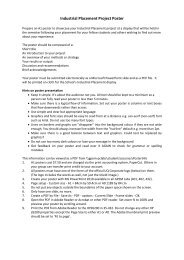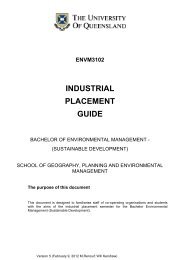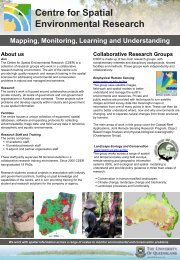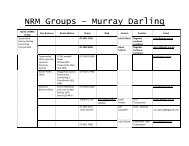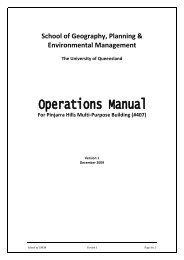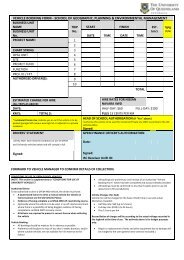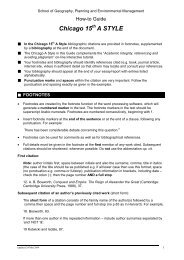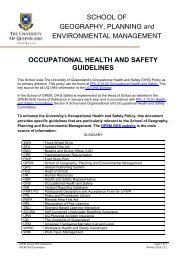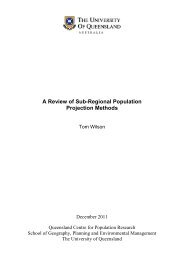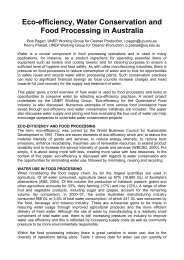Conserving Biodiversity in Brigalow Regrowth - School of ...
Conserving Biodiversity in Brigalow Regrowth - School of ...
Conserving Biodiversity in Brigalow Regrowth - School of ...
Create successful ePaper yourself
Turn your PDF publications into a flip-book with our unique Google optimized e-Paper software.
CONSERVING BIODIVERSITY IN BRIGALOW LANDSCAPES<br />
These movements can be much more difficult <strong>in</strong> agricultural<br />
areas. Animals differ <strong>in</strong> their ability to travel across open<br />
country to f<strong>in</strong>d other woodland patches and are at greater<br />
risk <strong>of</strong> predation when cross<strong>in</strong>g open country. Some<br />
animals can only move with<strong>in</strong> woodland patches, so if the<br />
woodland patch they live <strong>in</strong> is too small, they will perish or<br />
be unable to breed.<br />
Manag<strong>in</strong>g brigalow woodland<br />
patches for wildlife:<br />
Leav<strong>in</strong>g large patches <strong>of</strong> woodland on your property<br />
will provide habitat for those species that cannot<br />
travel across open country.<br />
Leav<strong>in</strong>g trees and patches, or even clumps <strong>of</strong><br />
regrowth, <strong>in</strong> your paddocks will ma<strong>in</strong>ta<strong>in</strong> connections<br />
between habitat patches by provid<strong>in</strong>g ‘stepp<strong>in</strong>g<br />
stones’ for the more mobile species.<br />
Connect<strong>in</strong>g your shade-l<strong>in</strong>es to one another will help<br />
animals that need to visit multiple brigalow woodland<br />
patches.<br />
Keep<strong>in</strong>g your shade-l<strong>in</strong>es as wide as possible, ideally<br />
> 100 m, will make it easier for animals to avoid the<br />
edges <strong>of</strong> woodland and farmland if they need to.<br />
MICHIALA BOWEN<br />
Tak<strong>in</strong>g <strong>in</strong> the big picture:<br />
the landscape<br />
Animal populations need to ma<strong>in</strong>ta<strong>in</strong> connections with other<br />
populations <strong>in</strong> the landscape to ma<strong>in</strong>ta<strong>in</strong> genetic diversity<br />
and long-term persistence.<br />
In def<strong>in</strong><strong>in</strong>g the term ‘landscape’, we need to th<strong>in</strong>k about<br />
<strong>in</strong>dividual animals to decide what makes a landscape for<br />
them. In general, a landscape is def<strong>in</strong>ed as an area <strong>of</strong> land<br />
that is large compared to the scale <strong>of</strong> movement <strong>of</strong> the<br />
animal and <strong>of</strong>ten <strong>in</strong>cludes both suitable and less-suitable<br />
habitat.<br />
A landscape for a t<strong>in</strong>y burrow<strong>in</strong>g frog can be only a<br />
few hundred metres across, while for a honeyeater, the<br />
landscape might be kilometres across.<br />
In a practical sense, it is best to th<strong>in</strong>k <strong>of</strong> a landscape <strong>in</strong><br />
terms <strong>of</strong> the area <strong>of</strong> land that you manage, i.e., the entire<br />
property or multiple neighbour<strong>in</strong>g properties. At this<br />
landscape scale, it is important to th<strong>in</strong>k about the total<br />
amount <strong>of</strong> woodland compared to areas <strong>of</strong> production <strong>in</strong><br />
your area <strong>of</strong> management, and how well connected it is to<br />
other areas <strong>of</strong> woodland.<br />
This doesn’t necessarily mean a physical l<strong>in</strong>e <strong>of</strong> trees –<br />
many animals can cross small gaps between patches – but<br />
if you are able to encourage woodland regeneration close<br />
to areas <strong>of</strong> exist<strong>in</strong>g woodland, this is better than creat<strong>in</strong>g an<br />
isolated patch.<br />
Most importantly, the more woodland cover you have <strong>in</strong><br />
your landscape, the better it is likely to be for wildlife. Every<br />
little bit counts.<br />
If you carefully th<strong>in</strong>k about how you manage the woodland<br />
stands, patches and entire landscape <strong>of</strong> your property then<br />
you are likely to achieve the best you can for a range <strong>of</strong><br />
animals.<br />
Manag<strong>in</strong>g your<br />
landscape for wildlife:<br />
Leav<strong>in</strong>g as much woodland <strong>in</strong> the landscape as<br />
possible will result <strong>in</strong> more wildlife.<br />
Protect woodland edges by avoid<strong>in</strong>g herbicide and<br />
pesticide spray drift <strong>in</strong>to woodland patches – this will<br />
help to avoid degradation and shr<strong>in</strong>kage <strong>of</strong> woodland<br />
patches.<br />
Good habitat quality at large scales can be achieved<br />
by work<strong>in</strong>g with neighbours to manage habitat on<br />
more than one property.<br />
13



